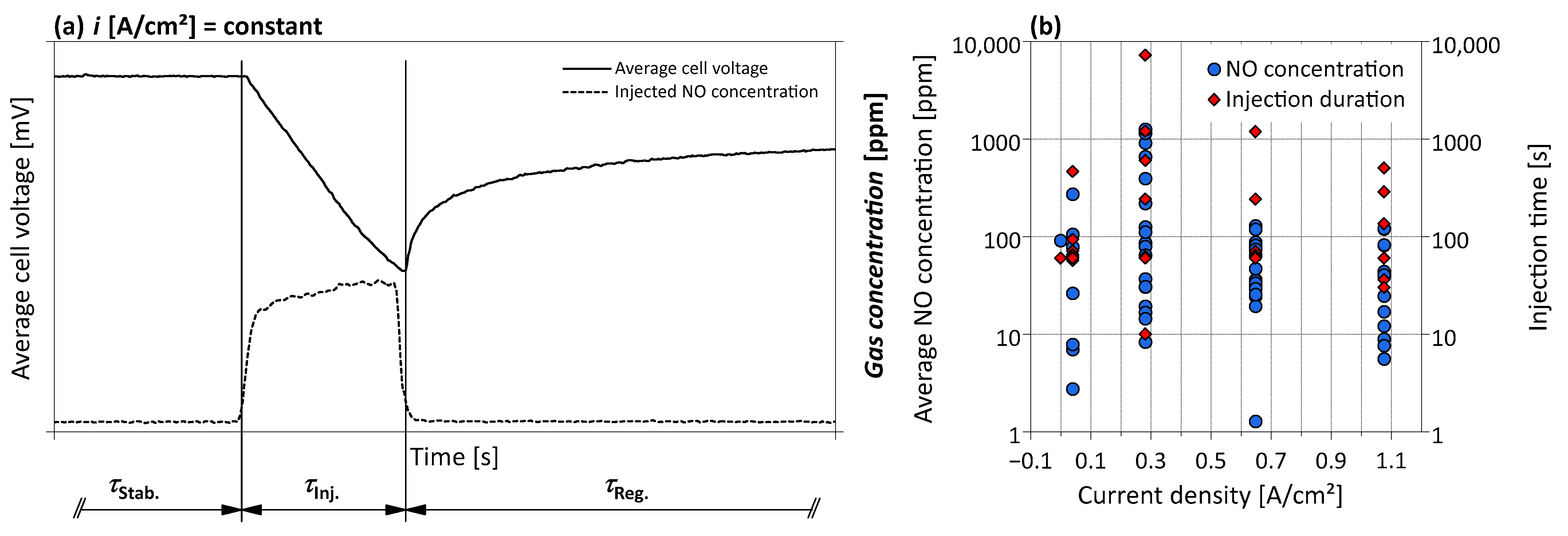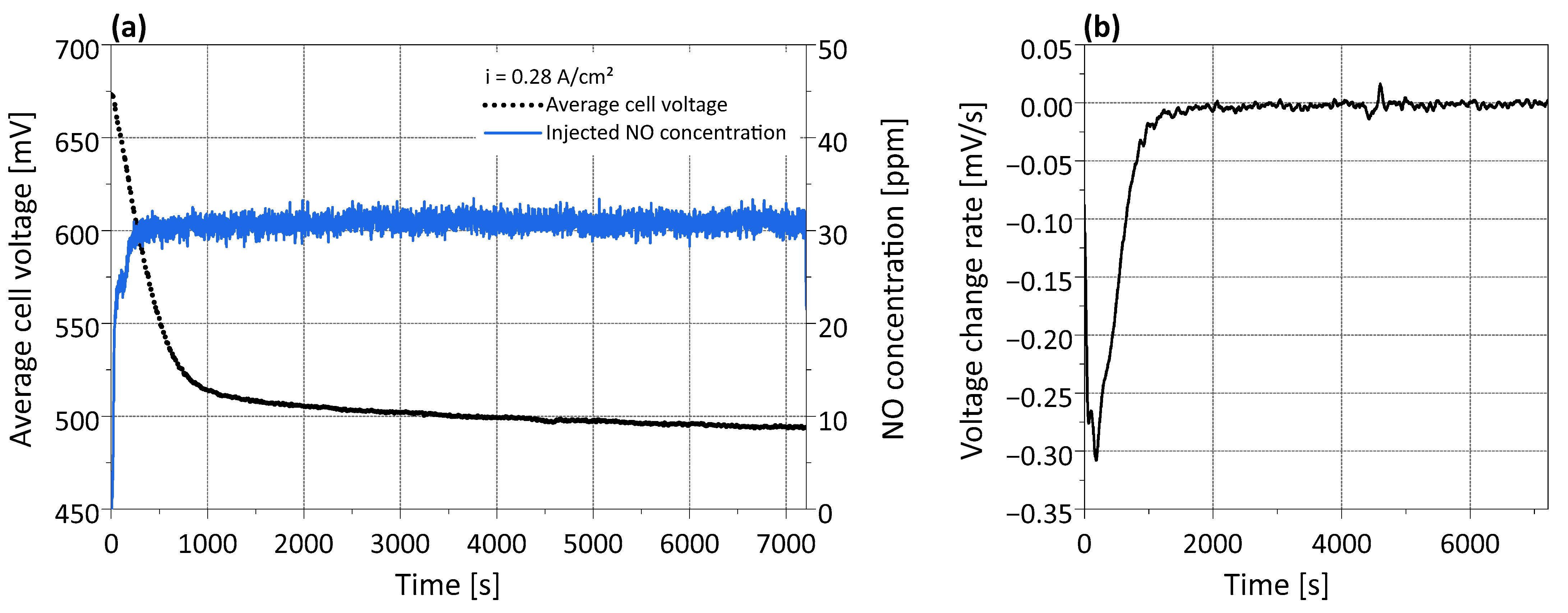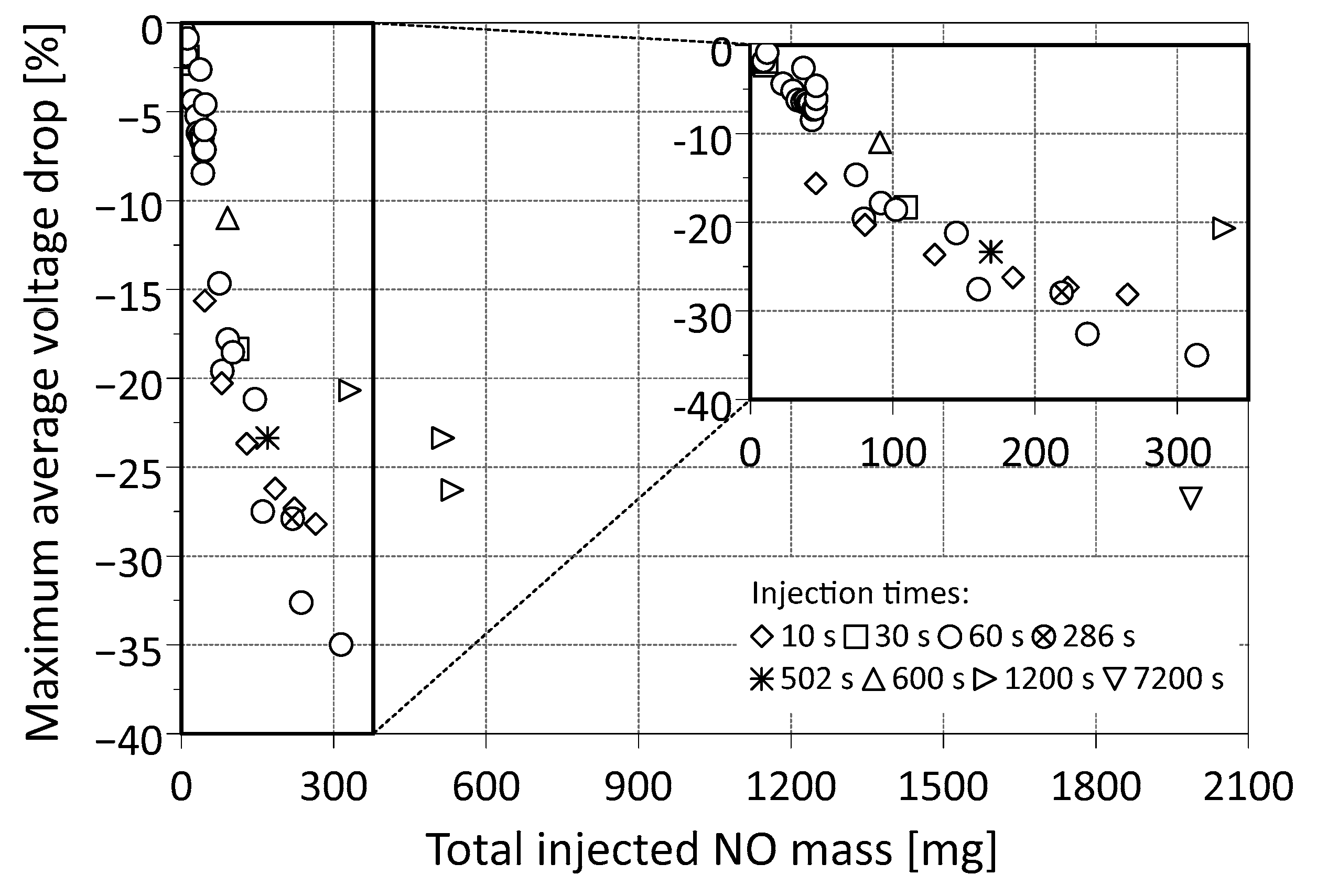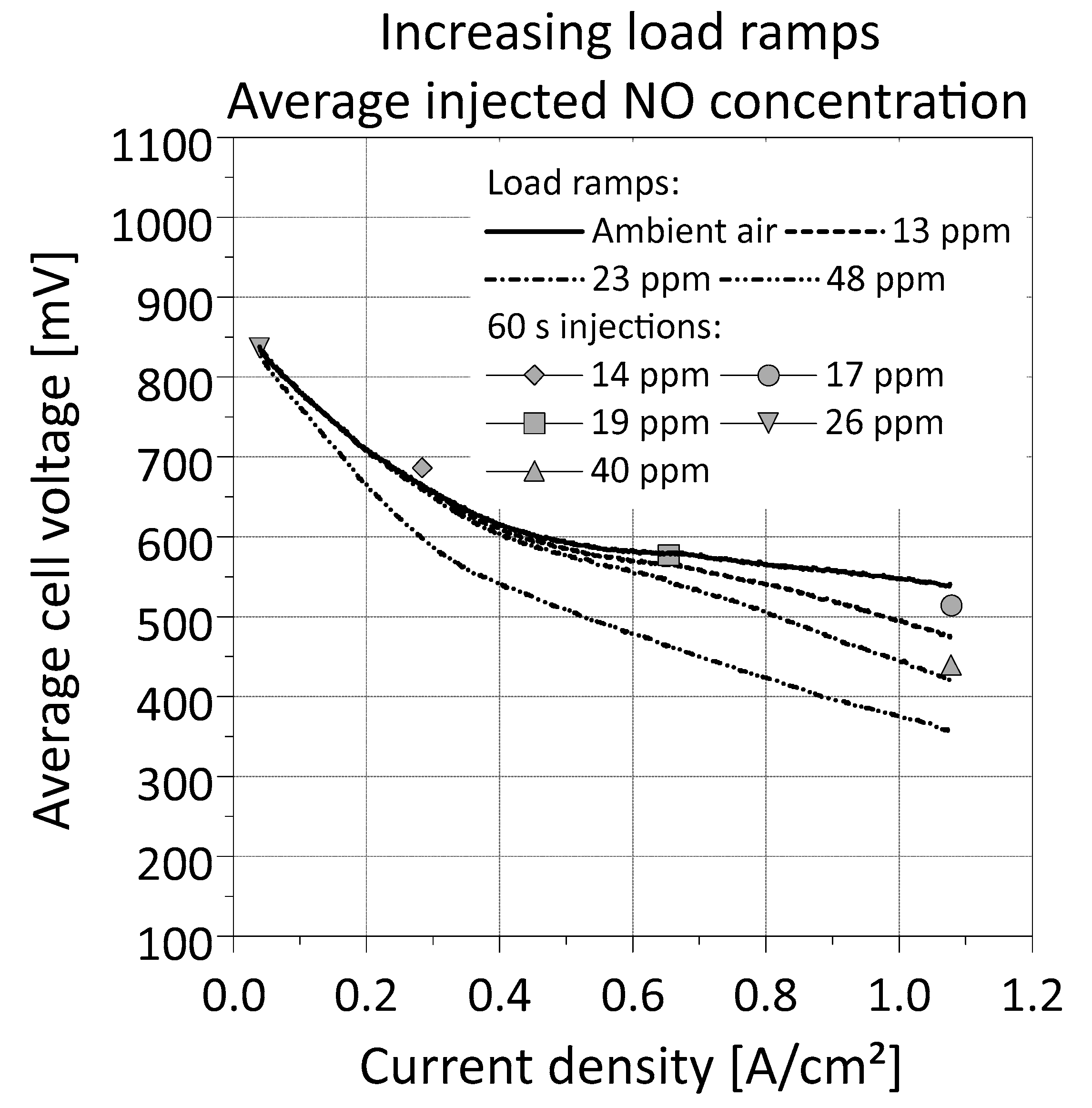Experimental Investigation of the Influence of NO on a PEM Fuel Cell System and Voltage Recovery Strategies
Abstract
1. Introduction
2. Materials and Methods
2.1. Experimental Setup
2.2. NO Injection Procedure
2.3. Voltage Recovery Procedure
2.3.1. Voltage Recovery during Fuel Cell Operation
2.3.2. Voltage Recovery without Fuel Cell Operation
2.3.3. Recovery Cycle
2.3.4. Evaluation Strategy
3. Results and Discussion
3.1. NO Injection Experiments
3.1.1. Effect on the Fuel Cell Stack
3.1.2. Short Time Injection
3.1.3. Long Time Injection
3.1.4. Comparison of Short- and Long-Time Injections
3.1.5. Variable Load Injection
3.2. Voltage Recovery Experiments
3.3. Overall System Degradation
4. Conclusions
Author Contributions
Funding
Data Availability Statement
Acknowledgments
Conflicts of Interest
References
- Trattner, A.; Klell, M.; Radner, F. Sustainable hydrogen society—Vision, findings and development of a hydrogen economy using the example of Austria. Int. J. Hydrogen Energy 2022, 47, 2059–2079. [Google Scholar] [CrossRef]
- Maggio, G.; Squadrito, G.; Nicita, A. Hydrogen and medical oxygen by renewable energy based electrolysis: A green and economically viable route. Appl. Energy 2022, 306, 117993. [Google Scholar] [CrossRef]
- Klell, M.; Eichlseder, H.; Trattner, A. Hydrogen in Automotive Engineering: Production, Storage, Application, 1st ed.; Springer Fachmedien Wiesbaden: Wiesbaden, Germany, 2023; pp. 10–20. [Google Scholar]
- Shabani, B.; Hafttananian, M.; Khamani, S.; Ramiar, A.; Ranjbar, A.A. Poisoning of proton exchange membrane fuel cells by contaminants and impurities: Review of mechanisms, effects, and mitigation strategies. J. Power Sources 2019, 427, 21–48. [Google Scholar] [CrossRef]
- Yang, D.-J.; Ma, X.-W.; Lv, H.; Li, B.; Zhang, C.-M. NO adsorption and temperature programmed desorption on K2CO3 modified activated carbons. J. Central South Univ. 2018, 25, 2339–2348. [Google Scholar] [CrossRef]
- Mikkola, M.S.; Rockward, T.; Uribe, F.A.; Pivovar, B.S. The Effect of NaCl in the Cathode Air Stream on PEMFC Performance. Fuel Cells 2007, 7, 153–158. [Google Scholar] [CrossRef]
- Cheng, X.; Shi, Z.; Glass, N.; Zhang, L.; Zhang, J.; Song, D.; Liu, Z.-S.; Wang, H.; Shen, J. A review of PEM hydrogen fuel cell contamination: Impacts, mechanisms, and mitigation. J. Power Sources 2007, 165, 739–756. [Google Scholar] [CrossRef]
- Nagahara, Y.; Sugawara, S.; Shinohara, K. The impact of air contaminants on PEMFC performance and durability. J. Power Sources 2008, 182, 422–428. [Google Scholar] [CrossRef]
- St-Pierre, J.; Zhai, Y.; Angelo, M.S. Effect of Selected Airborne Contaminants on PEMFC Performance. J. Electrochem. Soc. 2014, 161, F280–F290. [Google Scholar] [CrossRef]
- Misz, U.; Talke, A.; Heinzel, A.; Konrad, G. Sensitivity Analyses on the Impact of Air Contaminants on Automotive Fuel Cells. Fuel Cells 2016, 16, 444–462. [Google Scholar] [CrossRef]
- Qi, J.; Zhai, Y.; St-Pierre, J. Effect of contaminant mixtures in air on proton exchange membrane fuel cell performance. J. Power Sources 2019, 413, 86–97. [Google Scholar] [CrossRef]
- Lechner, B.; Schruth, R.; Fischbacher, B.; Cajic, A.; Ahamer, C. Cathodic Gaseous Analysis for Fuel Cell Vehicles in Real Driving Conditions. In Proceedings of the 43rd International Vienna Motor Symposium 2022, Wien, Austria, 27–29 April 2022. [Google Scholar]
- Talke, A.; Misz, U.; Konrad, G.; Heinzel, A.; Klemp, D.; Wegener, R. Influence of urban air on proton exchange membrane fuel cell vehicles—Long term effects of air contaminants in an authentic driving cycle. J. Power Sources 2018, 400, 556–565. [Google Scholar] [CrossRef]
- Bétournay, M.C.; Bonnell, G.; Edwardson, E.; Paktunc, D.; Kaufman, A.; Lomma, A. The effects of mine conditions on the performance of a PEM fuel cell. J. Power Sources 2004, 134, 80–87. [Google Scholar] [CrossRef]
- Mitzel, J.; Zhang, Q.; Gazdzicki, P.; Friedrich, K.A. Review on mechanisms and recovery procedures for reversible performance losses in polymer electrolyte membrane fuel cells. J. Power Sources 2021, 488, 229375. [Google Scholar] [CrossRef]
- Chen, M.; Du, C.; Zhang, J.; Wang, P.; Zhu, T. Effect, mechanism and recovery of nitrogen oxides poisoning on oxygen reduction reaction at Pt/C catalysts. J. Power Sources 2011, 196, 620–626. [Google Scholar] [CrossRef]
- Talke, A.; Misz, U.; Konrad, G.; Heinzel, A. Influence of Nitrogen Compounds on PEMFC: A Comparative Study. J. Electrochem. Soc. 2018, 165, F3111–F3117. [Google Scholar] [CrossRef]
- de Vooys, A.; Beltramo, G.; van Riet, B.; van Veen, J.; Koper, M. Mechanisms of electrochemical reduction and oxidation of nitric oxide. Electrochim. Acta 2004, 49, 1307–1314. [Google Scholar] [CrossRef]
- Uribe, F.A.; Gottesfeld, S.; Zawodzinski, T.A. Effect of Ammonia as Potential Fuel Impurity on Proton Exchange Membrane Fuel Cell Performance. J. Electrochem. Soc. 2002, 149, A293–A296. [Google Scholar] [CrossRef]
- Yang, D.; Ma, J.; Xu, L.; Wu, M.; Wang, H. The effect of nitrogen oxides in air on the performance of proton exchange membrane fuel cell. Electrochim. Acta 2006, 51, 4039–4044. [Google Scholar] [CrossRef]
- Misz, U.; Talke, A.; Heinzel, A.; Beckhaus, P. Effects, Damage Characteristics and Recovery Potential of Traffic-induced Nitric Oxide Emissions in PEM Fuel Cells under Variable Operating Conditions. Fuel Cells 2018, 18, 594–601. [Google Scholar] [CrossRef]
- Gomez, Y.A.; Lindbergh, G.; Lagergren, C. Performance Recovery after Contamination with Nitrogen Dioxide in a PEM Fuel Cell. Molecules 2020, 25, 1115. [Google Scholar] [CrossRef]
- St-Pierre, J.; Virji, M.B.V. Cell performance distribution in a low-temperature proton exchange membrane fuel cell stack during propene contamination. J. Appl. Electrochem. 2016, 46, 169–181. [Google Scholar] [CrossRef]
- Wallnöfer-Ogris, E.; Pertl, P.; Trattner, A. Quasi-stationary UI-characteristic model of a PEM fuel cell–Evaluating the option of self-humidifying operation. Int. J. Hydrogen Energy 2020, 45, 32464–32477. [Google Scholar] [CrossRef]
- Farberow, C.A.; Dumesic, J.A.; Mavrikakis, M. Density Functional Theory Calculations and Analysis of Reaction Pathways for Reduction of Nitric Oxide by Hydrogen on Pt(111). ACS Catal. 2014, 4, 3307–3319. [Google Scholar] [CrossRef]
- Bethune, K.; St-Pierre, J.; LaManna, J.M.; Hussey, D.S.; Jacobson, D.L. Contamination Mechanisms of Proton Exchange Membrane Fuel Cells—Mass Transfer Overpotential Origin. J. Phys. Chem. C 2020, 124, 24052–24065. [Google Scholar] [CrossRef]
- St-Pierre, J.; Zhai, Y. Impact of the Cathode Pt Loading on PEMFC Contamination by Several Airborne Contaminants. Molecules 2020, 25, 1060. [Google Scholar] [CrossRef]
- Zhai, Y.; Ge, J.; Qi, J.; St-Pierre, J. Effect of Acetonitrile Contamination on Long-Term Degradation of Proton Exchange Membrane Fuel Cells. J. Electrochem. Soc. 2018, 165, F3191–F3199. [Google Scholar] [CrossRef]








| Current Density Range: 0.04–1.08 [A/cm2] | |||||
|---|---|---|---|---|---|
| Cathode | Anode | Coolant | |||
| Flow rate | 6–30 [g/s] | Flow rate | 0.05–1.65 [kg/h] | Flow rate | 40–45 [L/min] |
| Pressure | 1.1–1.5 [barabs] | Pressure | 1.8 [barabs] | Temperature | 49 [°C] at Stack inlet |
| Stoichiometry | 11–1.9 [-] | Stoichiometry | 1.73–1.03 [-] | ||
| Current Density i [A/cm2] | Stabilization Time [s] | Injection Time [s] | NO Concentration [ppm] | Air Recovery Time [s] | |
|---|---|---|---|---|---|
| 0.0 | 600 | 10 | Short time injection | 5 to 3000 | 420 |
| 0.04 | 30 | 1200 | |||
| 0.28 | 60 | 7200 | |||
| 0.65 | 280 to 600 | Long time injection | |||
| 1.08 | 1200 | ||||
| 0.04 to 1.08 to 0.04 | 7200 | ||||
Disclaimer/Publisher’s Note: The statements, opinions and data contained in all publications are solely those of the individual author(s) and contributor(s) and not of MDPI and/or the editor(s). MDPI and/or the editor(s) disclaim responsibility for any injury to people or property resulting from any ideas, methods, instructions or products referred to in the content. |
© 2023 by the authors. Licensee MDPI, Basel, Switzerland. This article is an open access article distributed under the terms and conditions of the Creative Commons Attribution (CC BY) license (https://creativecommons.org/licenses/by/4.0/).
Share and Cite
Reithuber, P.; Poimer, F.; Brandstätter, S.; Schutting, E.; Buchberger, S.; Trattner, A.; Eichlseder, H. Experimental Investigation of the Influence of NO on a PEM Fuel Cell System and Voltage Recovery Strategies. Energies 2023, 16, 3720. https://doi.org/10.3390/en16093720
Reithuber P, Poimer F, Brandstätter S, Schutting E, Buchberger S, Trattner A, Eichlseder H. Experimental Investigation of the Influence of NO on a PEM Fuel Cell System and Voltage Recovery Strategies. Energies. 2023; 16(9):3720. https://doi.org/10.3390/en16093720
Chicago/Turabian StyleReithuber, Peter, Florian Poimer, Stefan Brandstätter, Eberhard Schutting, Simon Buchberger, Alexander Trattner, and Helmut Eichlseder. 2023. "Experimental Investigation of the Influence of NO on a PEM Fuel Cell System and Voltage Recovery Strategies" Energies 16, no. 9: 3720. https://doi.org/10.3390/en16093720
APA StyleReithuber, P., Poimer, F., Brandstätter, S., Schutting, E., Buchberger, S., Trattner, A., & Eichlseder, H. (2023). Experimental Investigation of the Influence of NO on a PEM Fuel Cell System and Voltage Recovery Strategies. Energies, 16(9), 3720. https://doi.org/10.3390/en16093720






